Siam Cement Bundle
How Does Siam Cement Company Thrive in a Dynamic Market?
Siam Cement Group (SCG), a century-old Thai multinational, is a titan of Southeast Asia's industrial landscape. From its origins in cement, SCG has diversified into a powerhouse, shaping the region's economic growth. Understanding Siam Cement SWOT Analysis is crucial for anyone seeking to navigate the complexities of regional markets and industrial innovation.
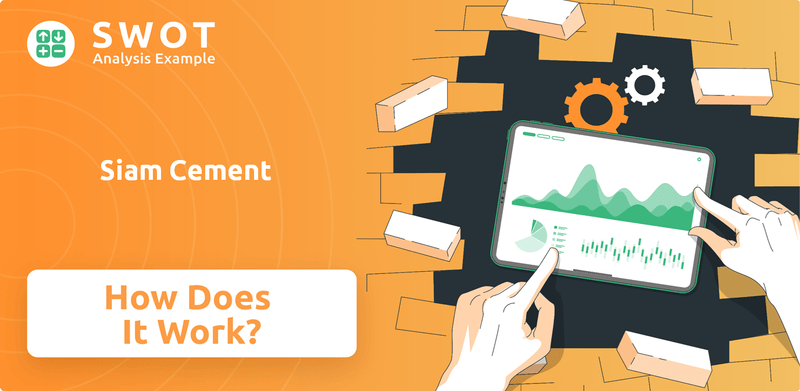
SCG's influence spans vital sectors, making it a key player for investors and industry observers. Its comprehensive product range, from construction materials to advanced chemicals, underscores its integral role in infrastructure and its commitment to innovation. This exploration into SCG operations will reveal the strategies behind its enduring success in the Thai cement industry and beyond.
What Are the Key Operations Driving Siam Cement’s Success?
The core operations of the Siam Cement Company (SCG) are structured around three main business segments: Cement-Building Materials, Chemicals, and Packaging. Each segment has distinct operational processes and value propositions, contributing to SCG's overall market position. Understanding these segments is key to grasping the scope of SCG's impact on the Thai cement industry and beyond.
SCG's operational model is characterized by its integrated supply chains, extensive regional presence, and commitment to innovation and sustainability. This approach supports efficient delivery and market penetration across the ASEAN region. The company's focus on green processes and products, such as low-carbon cement and recyclable packaging, differentiates it from competitors. Its core capabilities in large-scale manufacturing, logistics, and R&D enable the provision of comprehensive solutions, maximizing customer benefits and market differentiation.
SCG's strategy and operations are designed to create and deliver value through its diversified business segments. This approach allows SCG to serve multiple customer segments and adapt to changing market conditions. For a deeper dive into the company's strategic growth, consider exploring the Growth Strategy of Siam Cement.
This segment manufactures and distributes cement, concrete, roofing, and insulation. SCG serves construction companies, property developers, and homeowners. The operational process includes quarrying raw materials, advanced manufacturing, and an extensive logistics network. The value proposition includes consistent product quality, wide distribution, and integrated solutions.
The Chemicals business produces olefins, polyolefins, and other chemical products. These products cater to industries such as automotive, electronics, and consumer goods. This segment emphasizes advanced R&D, state-of-the-art production facilities, and a focus on high-value-added products and sustainable chemical solutions. SCG's strong supply chain for feedstock and its technological capabilities enable it to offer differentiated chemical products that meet stringent industry standards.
This segment provides fiber-based packaging, paper, and flexible packaging solutions. It serves various consumer goods companies and industrial clients. This involves sustainable sourcing of raw materials, efficient manufacturing processes, and innovative design capabilities. The focus is on meeting evolving customer demands for eco-friendly and functional packaging.
SCG's operations are unique due to its integrated supply chain, regional footprint, and commitment to innovation and sustainability. The company leverages strong partnerships and distribution networks across ASEAN. For example, SCG's focus on green processes and products, such as low-carbon cement and recyclable packaging, translates into benefits for customers seeking sustainable solutions and differentiates it from competitors.
SCG's success is underpinned by its strategic approach to manufacturing, distribution, and sustainability. The company's commitment to innovation and efficiency drives its ability to meet diverse market demands. SCG's financial performance reflects its operational strengths and strategic alignment.
- Manufacturing Excellence: SCG utilizes advanced manufacturing techniques in its cement plants.
- Logistics and Distribution: An extensive network ensures efficient product delivery across Southeast Asia.
- Innovation and Sustainability: Focus on green processes and products, such as low-carbon cement.
- Market Differentiation: Comprehensive solutions from raw materials to finished products.
Siam Cement SWOT Analysis
- Complete SWOT Breakdown
- Fully Customizable
- Editable in Excel & Word
- Professional Formatting
- Investor-Ready Format
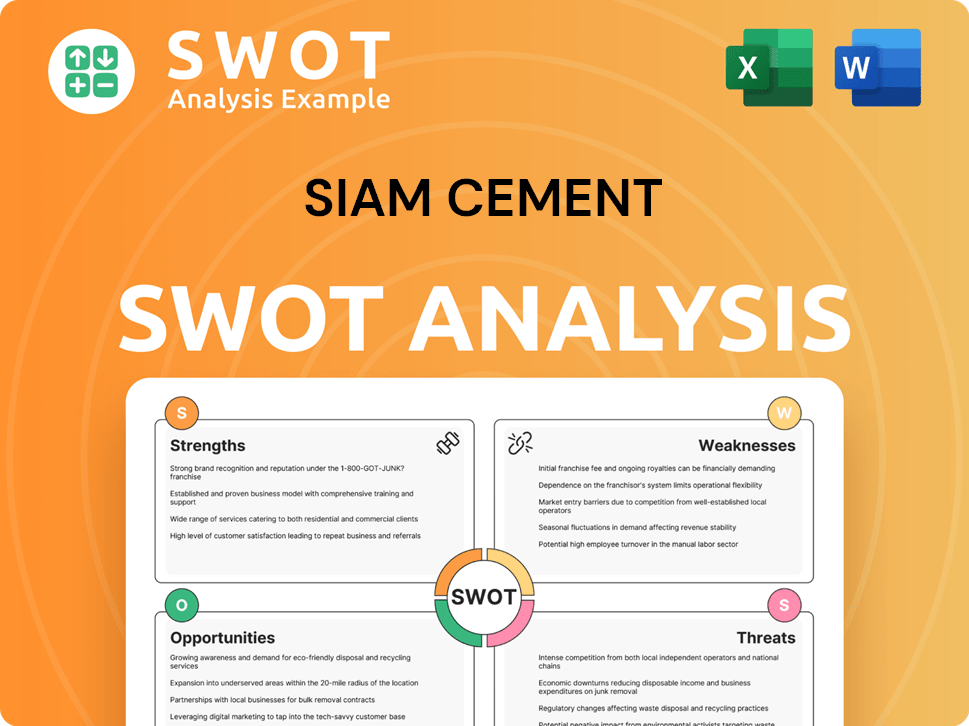
How Does Siam Cement Make Money?
Understanding the revenue streams and monetization strategies of the Siam Cement Company (SCG) is crucial for grasping its financial dynamics. SCG's operations are multifaceted, with revenue generated across several key business segments. This diversification allows the company to navigate market fluctuations and maintain a strong financial position within the Thai cement industry and beyond.
SCG's approach to generating revenue is strategic, focusing on both product sales and value-added services. The company continually adapts its strategies to meet evolving market demands and consumer preferences. This adaptability is a key factor in its sustained success and ability to contribute significantly to Thailand's economy.
SCG's revenue streams are primarily channeled through three core business segments: Cement-Building Materials, Chemicals, and Packaging. Each segment contributes substantially to the group's overall financial performance. The SCG business model is designed to leverage synergies between these segments, enhancing operational efficiency and market reach.
The Cement-Building Materials business is a cornerstone of SCG's operations. This segment generates revenue through the sale of cement, ready-mixed concrete, building materials, and housing products. It consistently contributes a significant portion of the group's total revenue, reflecting its foundational role in infrastructure and construction across the region. In 2023, this segment reported sales revenue of 179,350 million Thai Baht, representing approximately 40% of SCG's total sales.
- Products: Cement, ready-mixed concrete, building materials, and housing products.
- Key Role: Supports infrastructure and construction projects.
- 2023 Revenue: 179,350 million Thai Baht.
- Percentage of Total Sales (2023): Approximately 40%.
The Chemicals business is another major revenue driver for SCG. It derives income from the sale of olefins, polyolefins, and other chemical products used in various downstream industries. This segment's revenue can be influenced by global petrochemical prices and demand. For 2023, the Chemicals business recorded sales revenue of 188,460 million Thai Baht, making it the largest contributor at roughly 42% of the total sales.
- Products: Olefins, polyolefins, and other chemical products.
- Market Influence: Global petrochemical prices and demand.
- 2023 Revenue: 188,460 million Thai Baht.
- Percentage of Total Sales (2023): Approximately 42%.
The Packaging business generates revenue from the sale of fiber-based packaging, paper, and flexible packaging solutions to a diverse customer base. This segment's performance is often linked to consumer spending and e-commerce growth. In 2023, the Packaging business contributed 128,707 million Thai Baht in sales revenue.
- Products: Fiber-based packaging, paper, and flexible packaging solutions.
- Market Drivers: Consumer spending and e-commerce.
- 2023 Revenue: 128,707 million Thai Baht.
SCG's monetization strategies extend beyond simple product sales, incorporating value-added services and solutions within each segment. For instance, in building materials, they offer integrated construction solutions. In chemicals, the focus is on high-value-added products. The company also employs strategies like cross-selling and optimizing logistics to enhance profitability. For a deeper understanding of SCG's operations, including its history and evolution, further insights can be found in this article about Siam Cement Company.
Siam Cement PESTLE Analysis
- Covers All 6 PESTLE Categories
- No Research Needed – Save Hours of Work
- Built by Experts, Trusted by Consultants
- Instant Download, Ready to Use
- 100% Editable, Fully Customizable
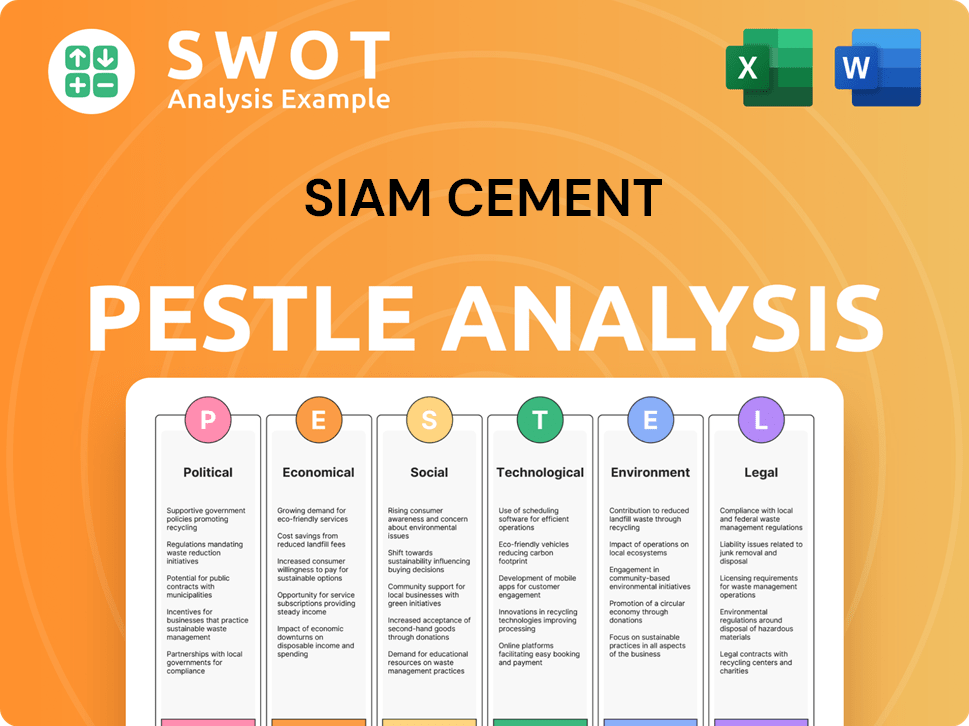
Which Strategic Decisions Have Shaped Siam Cement’s Business Model?
The journey of the Siam Cement Company (SCG) has been marked by significant milestones and strategic shifts, shaping its operational and financial landscape. A key strategic move has been its aggressive expansion across the ASEAN region, establishing manufacturing bases and distribution networks in countries like Vietnam, Indonesia, the Philippines, and Cambodia. This geographical diversification has allowed SCG to capitalize on the robust economic growth and infrastructure development in these emerging markets, reducing its reliance on the domestic market.
SCG has consistently invested in technological advancements and innovation, particularly in sustainable solutions. For instance, SCG has focused on developing low-carbon cement products and promoting circular economy principles within its operations, responding to growing environmental concerns and regulatory pressures. The company's ability to adapt to changing market dynamics and regulatory requirements is a testament to its forward-thinking approach.
Operational challenges have included volatility in raw material prices, especially for petrochemical feedstocks, and intense competition in certain segments. SCG has responded by optimizing its production processes, enhancing supply chain efficiency, and pursuing strategic partnerships to secure raw material supply and expand market access. The COVID-19 pandemic, for example, presented supply chain disruptions and reduced demand in some sectors, to which SCG adapted by accelerating digitalization and strengthening its e-commerce channels.
SCG's history is rich with milestones, including its founding in 1913 by Royal Decree of King Rama VI. Over the decades, it has evolved from a cement manufacturer to a diversified conglomerate. Recent years have seen a strong emphasis on regional expansion and sustainability initiatives.
Key strategic moves include regional expansion, particularly in ASEAN countries, and investments in sustainable technologies. SCG has also focused on integrating its business model to create synergies across different sectors. These moves have positioned SCG for long-term growth.
SCG's competitive advantages include its strong brand, economies of scale, and integrated business model. Its commitment to innovation and sustainability further strengthens its market position. The company's ability to adapt to market changes and maintain a diversified portfolio is also a significant advantage.
In 2024, SCG continues to focus on sustainable solutions, with investments in green technologies and circular economy practices. The company is also expanding its digital initiatives to improve operational efficiency and customer experience. SCG's financial performance in 2024 reflects its resilience and strategic focus.
SCG's competitive advantages are multifaceted, including brand strength, economies of scale, and an integrated business model. These factors enable SCG to maintain a strong market position in the Thai cement industry and beyond. SCG's commitment to innovation and sustainability further enhances its competitive edge.
- Strong Brand: Built over a century, instilling trust and loyalty.
- Economies of Scale: Significant in manufacturing and logistics, providing cost efficiencies.
- Integrated Business Model: Spanning raw materials to finished products, creating synergies.
- R&D Capabilities: Continuous innovation and sustainable solutions.
SCG's commitment to sustainability is evident in its initiatives to reduce carbon emissions and promote circular economy principles. In 2024, SCG announced plans to further reduce its carbon footprint through investments in renewable energy and energy-efficient technologies. These efforts align with global sustainability goals and enhance SCG's reputation as a responsible corporate citizen. For a deeper dive into the company's origins and evolution, you can read more in the Brief History of Siam Cement.
Siam Cement Business Model Canvas
- Complete 9-Block Business Model Canvas
- Effortlessly Communicate Your Business Strategy
- Investor-Ready BMC Format
- 100% Editable and Customizable
- Clear and Structured Layout
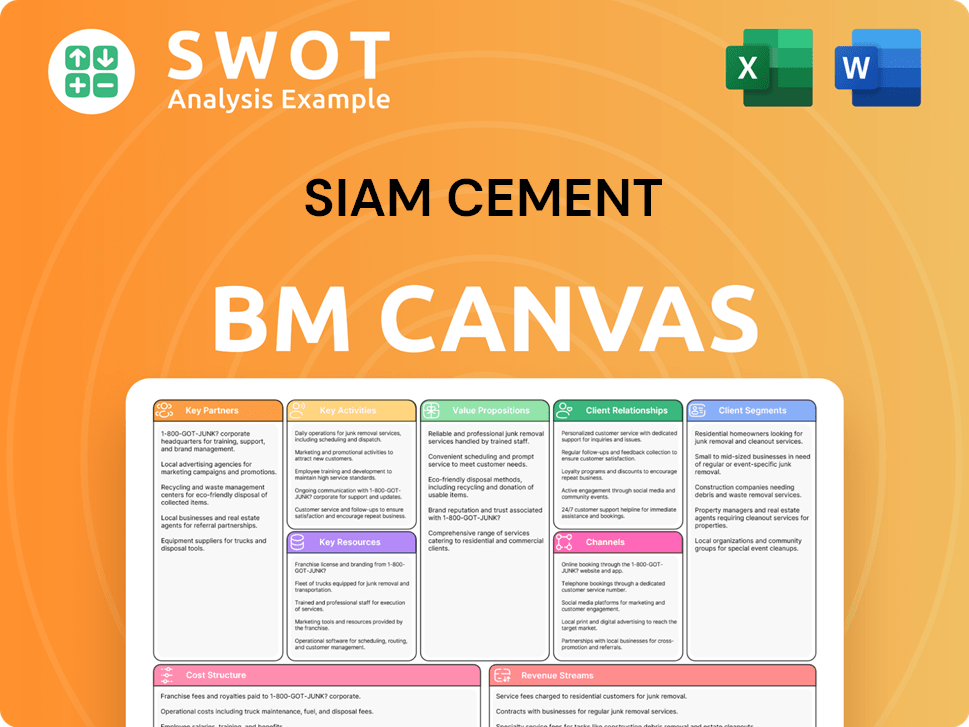
How Is Siam Cement Positioning Itself for Continued Success?
The Siam Cement Company (SCG) holds a strong position in Southeast Asia, especially in cement and building materials, chemicals, and packaging. The company has a significant market share in Thailand and has expanded across ASEAN countries, becoming a regional leader. Its long-standing reputation, extensive distribution networks, and diverse product portfolio contribute to strong customer loyalty. SCG's main focus is in Southeast Asia, where it uses its understanding of local markets and strong relationships with regional partners. For more information on their growth strategy, check out this article: Growth Strategy of Siam Cement.
Despite its strong market position, SCG faces several risks. Volatility in global raw material prices, especially for petrochemicals, can affect its Chemicals business. Economic downturns or political instability in its key markets could also impact demand for building materials and other products. Increasing environmental regulations and the push for decarbonization present both challenges and opportunities, requiring investments in green technologies and sustainable practices. New competitors or technological disruptions could erode its market share if not addressed proactively.
SCG is a dominant player in the Thai cement industry and across Southeast Asia. It has a strong presence in cement, building materials, chemicals, and packaging. SCG's operations are strategically positioned to capitalize on regional growth.
The company faces risks from fluctuating raw material prices, particularly in petrochemicals. Economic downturns and political instability in key markets pose challenges. Environmental regulations and competition are also significant factors.
SCG is focused on sustainability, innovation, and regional expansion. It is investing in green technologies and high-value-added products. The company aims to grow in ASEAN markets and enhance its circular economy approach.
SCG's business model emphasizes operational excellence and sustainable solutions. It focuses on strategic investments in synergistic businesses. This approach ensures long-term resilience and profitability in a changing global environment.
SCG is actively pursuing several strategic initiatives to ensure future growth and sustainability. These include investments in green technologies and the development of high-value-added products. The company is also expanding its presence in high-growth ASEAN markets.
- Focus on sustainability through low-carbon cement and recycling technologies.
- Enhancement of high-value-added products and services.
- Expansion within ASEAN markets to capitalize on regional growth.
- Commitment to circular economy principles and digital transformation.
Siam Cement Porter's Five Forces Analysis
- Covers All 5 Competitive Forces in Detail
- Structured for Consultants, Students, and Founders
- 100% Editable in Microsoft Word & Excel
- Instant Digital Download – Use Immediately
- Compatible with Mac & PC – Fully Unlocked
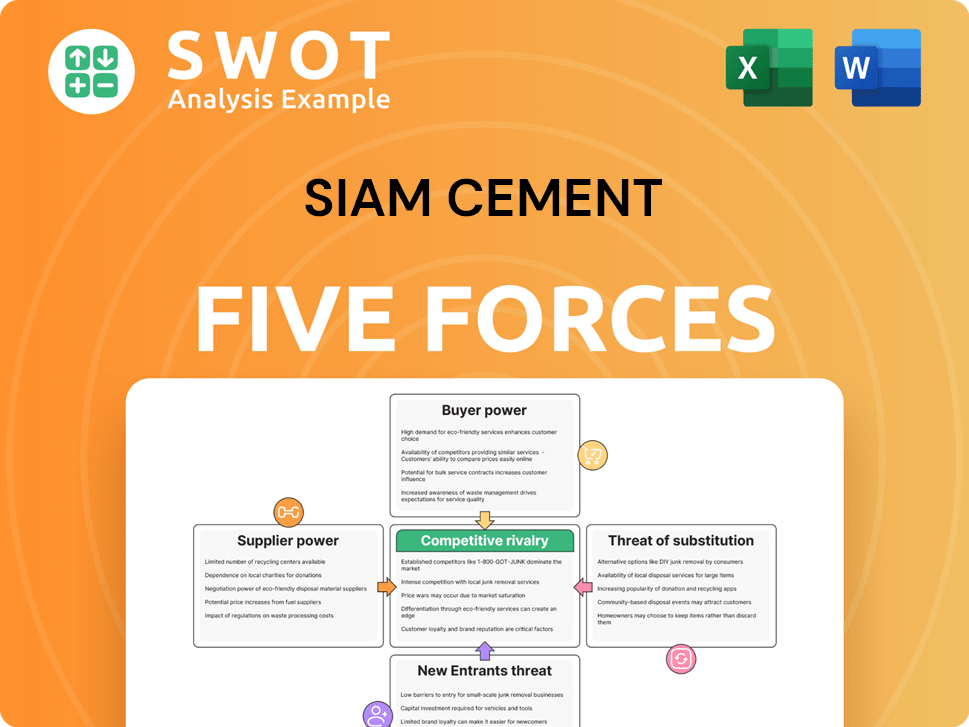
Related Blogs
- What are Mission Vision & Core Values of Siam Cement Company?
- What is Competitive Landscape of Siam Cement Company?
- What is Growth Strategy and Future Prospects of Siam Cement Company?
- What is Sales and Marketing Strategy of Siam Cement Company?
- What is Brief History of Siam Cement Company?
- Who Owns Siam Cement Company?
- What is Customer Demographics and Target Market of Siam Cement Company?
Disclaimer
All information, articles, and product details provided on this website are for general informational and educational purposes only. We do not claim any ownership over, nor do we intend to infringe upon, any trademarks, copyrights, logos, brand names, or other intellectual property mentioned or depicted on this site. Such intellectual property remains the property of its respective owners, and any references here are made solely for identification or informational purposes, without implying any affiliation, endorsement, or partnership.
We make no representations or warranties, express or implied, regarding the accuracy, completeness, or suitability of any content or products presented. Nothing on this website should be construed as legal, tax, investment, financial, medical, or other professional advice. In addition, no part of this site—including articles or product references—constitutes a solicitation, recommendation, endorsement, advertisement, or offer to buy or sell any securities, franchises, or other financial instruments, particularly in jurisdictions where such activity would be unlawful.
All content is of a general nature and may not address the specific circumstances of any individual or entity. It is not a substitute for professional advice or services. Any actions you take based on the information provided here are strictly at your own risk. You accept full responsibility for any decisions or outcomes arising from your use of this website and agree to release us from any liability in connection with your use of, or reliance upon, the content or products found herein.